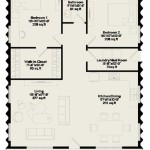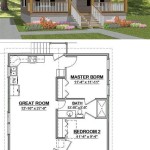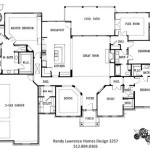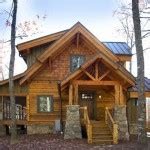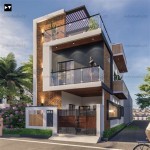6 Bedroom House Plans: Single Story Design for Your Dream Homestyle
The prospect of designing a home can be both exciting and daunting. For larger families or those who frequently host guests, the need for ample space becomes paramount. A six-bedroom house plan, designed with a single-story layout, presents a compelling solution, offering accessibility, convenience, and the potential for a seamless integration of indoor and outdoor living. This article explores the key considerations, advantages, and design elements that contribute to the creation of a functional and aesthetically pleasing six-bedroom single-story home.
Single-story homes, also known as ranch-style houses, avoid the challenges associated with stairs. This is particularly beneficial for families with young children, elderly members, or individuals with mobility limitations. The absence of stairs facilitates easier movement throughout the house and significantly reduces the risk of falls. Furthermore, single-story designs often allow for more flexible floor plans, enabling a more open and flowing layout. The inherent simplicity in construction can potentially translate to lower building costs compared to multi-story homes, although this can vary depending on the overall size and complexity of the design.
Designing a six-bedroom home on a single story requires careful planning to ensure that the space is utilized effectively. Balancing the need for private bedrooms with the desire for spacious common areas is a crucial aspect of the design process. Considerations must be given to the placement of bedrooms relative to living areas to minimize noise disruption and maximize privacy. Proper zoning of the house, with distinct areas for sleeping, living, and entertaining, is essential for creating a comfortable and functional living environment.
Key Considerations in Designing a Six-Bedroom Single Story House Plan
Several factors must be taken into account when developing a six-bedroom single-story house plan. Addressing these considerations proactively will contribute to a more successful and satisfying outcome. These include site constraints, budget limitations, and lifestyle requirements.
Site Constraints: The size and shape of the building lot significantly impact the design of a single-story home. A larger lot is generally required to accommodate a six-bedroom house plan on a single level. The topography of the land also plays a role, as a sloped lot may necessitate additional grading or foundation work, potentially increasing construction costs. The orientation of the lot relative to the sun is another important consideration. Strategic placement of windows and outdoor living spaces can maximize natural light and solar gain during the winter months while minimizing heat gain during the summer. Local building codes and zoning regulations must also be adhered to, including setback requirements, height restrictions, and limitations on impervious surfaces.
Budget Limitations: Establishing a realistic budget is crucial before embarking on the design process. The cost of building a six-bedroom single-story home can vary widely depending on the size of the house, the quality of materials used, the complexity of the design, and the location of the property. It is important to obtain detailed cost estimates from qualified contractors and to factor in contingency funds for unforeseen expenses. Value engineering, which involves identifying ways to reduce costs without compromising quality, may be necessary to stay within budget. This might include simplifying the design, selecting more affordable materials, or reducing the size of certain rooms.
Lifestyle Requirements: The design of a home should reflect the lifestyle and needs of its occupants. A six-bedroom house plan should consider the number of people who will be living in the house, their ages, their hobbies, and their lifestyle preferences. For example, a family with young children may prioritize a large playroom or a fenced-in backyard, while a couple who enjoys entertaining may want a spacious living room and a well-equipped kitchen. The need for a home office, a media room, or a guest suite may also influence the design. Understanding these lifestyle requirements early in the design process will ensure that the finished home meets the specific needs of its residents.
Advantages of a Single Story, Six Bedroom Design
Opting for a single-story design offers several distinct advantages, particularly for a larger home with multiple bedrooms. These advantages relate to accessibility, maintenance, and potentially lowering energy costs. They also offer greater ease of expansion.
Accessibility and Safety: As previously mentioned, the absence of stairs makes single-story homes inherently more accessible and safer for individuals with mobility limitations. This is particularly important for families with elderly members or individuals with disabilities. The absence of stairs also reduces the risk of falls, which can be a significant concern for young children. Furthermore, single-story homes are often easier to navigate and evacuate in the event of an emergency.
Ease of Maintenance: Single-story homes are generally easier to maintain than multi-story homes. Exterior maintenance, such as painting, window cleaning, and gutter cleaning, can be performed more easily and safely from ground level. Roof repairs are also typically less complex and less expensive on a single-story home. Interior maintenance, such as cleaning and dusting, is also simplified without the need to carry equipment up and down stairs.
Potential Energy Savings: Single-story homes can be more energy-efficient than multi-story homes, particularly in warmer climates. Heat rises, so in a multi-story home, the upper floors tend to be warmer than the lower floors. This can lead to uneven temperatures and increased energy consumption for heating and cooling. Single-story homes, on the other hand, tend to have more consistent temperatures throughout, reducing the need for excessive heating or cooling. Furthermore, single-story homes often have a smaller roof area relative to their square footage, which can reduce heat loss in the winter and heat gain in the summer.
Easier Expansion: Extending a single-story home is often simpler and less expensive than adding onto a multi-story structure. With a single-story design, the foundation is already in place, and the roof can be extended relatively easily. Adding a second story, on the other hand, requires significant structural modifications and can be a more complex and costly undertaking. The ease of expansion makes single-story homes a more flexible option for families who anticipate needing more space in the future.
Design Elements for an Effective Six-Bedroom Single Story Layout
Creating a functional and aesthetically pleasing six-bedroom single-story home requires careful consideration of various design elements. These elements include the use of zoning principles, maximizing natural light, incorporating outdoor living spaces, and selecting appropriate finishes and materials.
Zoning Principles: Zoning involves dividing the house into distinct areas based on function. A well-zoned home will typically have separate areas for sleeping, living, and entertaining. The bedroom wing should be located away from the main living areas to minimize noise disruption and maximize privacy. The living room, dining room, and kitchen should be grouped together to create a cohesive and inviting space for socializing. The placement of bathrooms should be carefully considered to ensure convenient access from all areas of the house. Zoning also plays a role in controlling the flow of traffic through the house, preventing congestion and ensuring that each area feels comfortable and functional.
Maximizing Natural Light: Natural light is essential for creating a bright and airy living environment. The strategic placement of windows and skylights can maximize natural light penetration throughout the house. Larger windows should be placed on the south-facing side of the house to capture solar gain during the winter months. Overhangs and awnings can be used to shade windows during the summer months, preventing excessive heat gain. Skylights can be used to bring natural light into areas that do not have access to exterior walls. Light wells can also be incorporated into the design to bring natural light into interior spaces. Choosing light-colored interior paint and finishes can further enhance the brightness of the house.
Incorporating Outdoor Living Spaces: Integrating outdoor living spaces into the design of a home can extend the living area and create a seamless connection between indoors and outdoors. Patios, decks, and porches can be used to create comfortable outdoor entertaining areas. Outdoor kitchens and fireplaces can further enhance the functionality of these spaces. The placement of outdoor living spaces should be carefully considered to take advantage of views and to provide shade and privacy. Landscaping can also be used to create a more inviting and relaxing outdoor environment. Consider incorporating a covered porch or patio to provide shade during hot weather and protection from the elements.
Selecting Appropriate Finishes and Materials: The finishes and materials used in a home can significantly impact its appearance and functionality. Selecting durable and low-maintenance materials is important for reducing long-term maintenance costs. Choosing energy-efficient windows and doors can help to reduce energy consumption. The color palette should be carefully considered to create a cohesive and harmonious look throughout the house. Selecting flooring materials that are appropriate for each area of the house is also important. For example, tile or laminate flooring may be a good choice for kitchens and bathrooms, while carpet or hardwood flooring may be more appropriate for bedrooms and living rooms.
In conclusion, designing a six-bedroom single-story house plan requires careful planning and attention to detail. By considering site constraints, budget limitations, and lifestyle requirements, and by incorporating key design elements such as zoning principles, maximizing natural light, and incorporating outdoor living spaces, one can create a functional, comfortable, and aesthetically pleasing home that meets the specific needs of its occupants. The advantages of a single-story design, including accessibility, ease of maintenance, and potential energy savings, make it an attractive option for larger families or those who prioritize convenience and long-term value.

Dream Single Story House Plans Customizable One Homes

Spanish Colonial Home Plans Sater Design Collection

Single Storied House Design
Excited To Share My Dream House Plans

Southern House Plans Style Home Designs The Designers

The 22 Best Single Story House Plans With Courtyard Jhmrad
Excited To Share My Dream House Plans

Luxury House Plans Sater Design Collection

Country House Plans French English Low Modern Ranch

Georgia House Plans Styles Designs Floor
Related Posts

